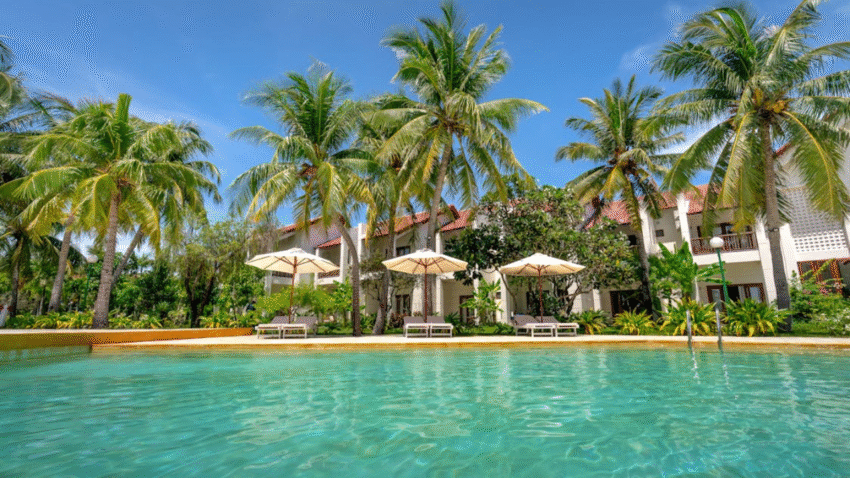Introduction
Is your pool water turning green just days after cleaning it? It’s frustrating, but common. The good news is that you can stop it from happening with the right care. This guide will teach you how to prevent pool water from turning green using proven, step-by-step strategies. Whether you’re a new pool owner or looking to stay ahead of summer algae, this guide will help you keep your water sparkling clean and inviting.
Why Green Pool Water Happens (And Why Prevention Matters)
Green pool water is almost always a sign of algae growth, often caused by poor water balance, lack of chlorine, or poor circulation. Algae thrives in warm, unbalanced water and can take over quickly—sometimes overnight.
Reasons to prevent green water:
- Algae makes water unsafe to swim in
- It clogs filters and stains pool surfaces
- It causes cloudy water and chemical imbalances
- Cleaning a green pool is time-consuming and expensive
Preventing algae growth is far easier (and cheaper) than treating it after the fact.
Step-by-Step Guide to Preventing Green Pool Water
Step 1: Maintain Proper Chlorine Levels
Chlorine is your pool’s first line of defense. If levels drop too low, algae can bloom fast.
- Keep free chlorine between 1.0–3.0 ppm
- Test at least 2–3 times a week, daily during summer
- Use chlorine tablets for slow-release and shock the pool weekly
Tip: Shocking the pool (super-chlorination) is essential after heavy usage, storms, or if chlorine dips below target.
Step 2: Balance Your Water Chemistry
Imbalanced water creates the perfect environment for algae and reduces chlorine’s effectiveness.
Keep these ranges:
- pH: 7.2–7.6
- Alkalinity: 80–120 ppm
- Calcium Hardness: 200–400 ppm
- Cyanuric Acid (stabilizer): 30–50 ppm
Test and adjust weekly to prevent chemical shifts that lead to algae.
Step 3: Brush and Vacuum Weekly
Algae can start growing on surfaces before it’s even visible. Prevent it by brushing walls, steps, and corners regularly.
- Brush at least once per week
- Vacuum manually or use an automatic cleaner
- Focus on shady or low-flow areas where algae likes to grow
Caution: Brushing is especially important if your pool has plaster or textured surfaces.
Step 4: Keep Your Filter Clean and Running
Good filtration prevents algae by removing contaminants and keeping water circulating.
- Run the pump 8–12 hours a day, especially during warm months
- Backwash sand/DE filters every 1–2 weeks
- Clean cartridge filters monthly or as needed
Tip: Check filter pressure weekly. A sudden rise may indicate it’s time to clean or backwash.
Step 5: Use an Algaecide Preventatively
A quality algaecide used weekly can prevent green water from ever forming.
- Choose a non-copper algaecide to avoid metal staining
- Add it after chlorine has stabilized, not at the same time as shocking
- Follow the dosage on the product label carefully
Step 6: Cover Your Pool When Not in Use
Leaves, bugs, and debris not only make your pool dirty—they also feed algae.
- Use a solar cover or mesh safety cover when the pool is unused
- Clean your pool cover regularly to prevent debris buildup
- Use a leaf net if your pool is near trees
Step 7: Eliminate Phosphates
Phosphates are nutrients that algae feed on. High levels can promote growth even in well-chlorinated water.
- Test phosphate levels monthly
- Use a phosphate remover if levels are above 500 ppb
- Avoid fertilizer or lawn runoff near the pool
Want to learn more? Check out our full guide on [How to Treat High Phosphates in Your Pool].
Common Mistakes to Avoid
1. Letting Chlorine Drop Too Low
Even a day or two with low chlorine can trigger algae growth.
Solution: Use a chlorine floater or feeder and shock regularly.
2. Ignoring pH and Alkalinity
Imbalanced water weakens chlorine and promotes algae.
Solution: Test your water weekly and adjust as needed.
3. Poor Circulation
Dead spots in corners or steps are algae’s favorite hiding places.
Solution: Adjust your return jets to improve circulation and brush those areas weekly.
4. Overuse of Algaecide
Using too much can lead to cloudy water and chemical imbalance.
Solution: Follow dosage directions and only use algaecide as a preventative—not a replacement for chlorine.
5. Skipping Weekly Maintenance
Algae prevention requires consistency.
Solution: Set a maintenance schedule and stick to it—especially during hot weather or high swimmer traffic.
Extra Tips & Pool Hacks
- Add enzymes to your pool to break down oils and organic waste that algae love.
- Use a pool water clarifier weekly to help your filter catch tiny particles before they cause trouble.
- Position return jets downward and slightly angled for better circulation across all areas.
- Keep landscaping tidy to reduce leaf litter and organic debris in the water.
Bonus Resource: Need help setting a maintenance schedule? See our article on [How to Maintain Pool Water Clarity].
Conclusion
Preventing green pool water is all about consistency. With the right balance of chlorine, proper water chemistry, regular brushing, and clean filtration, algae won’t stand a chance. It’s far easier to prevent a green pool than to fix one—and your pool will look better, stay safer, and be more fun to swim in all season long.
Final tip: Treat your pool like your car—regular care goes a long way. Just 15–20 minutes a few times per week can save you hours of frustration and costly chemical treatments later.
